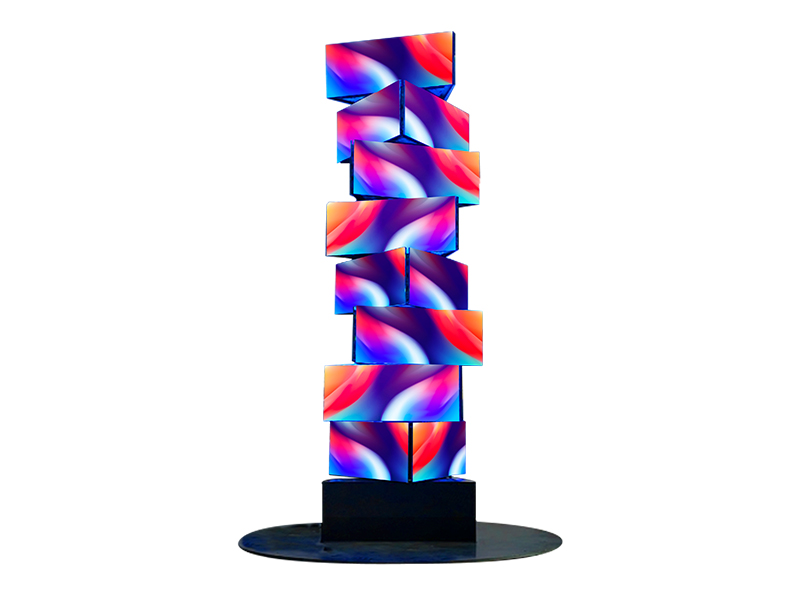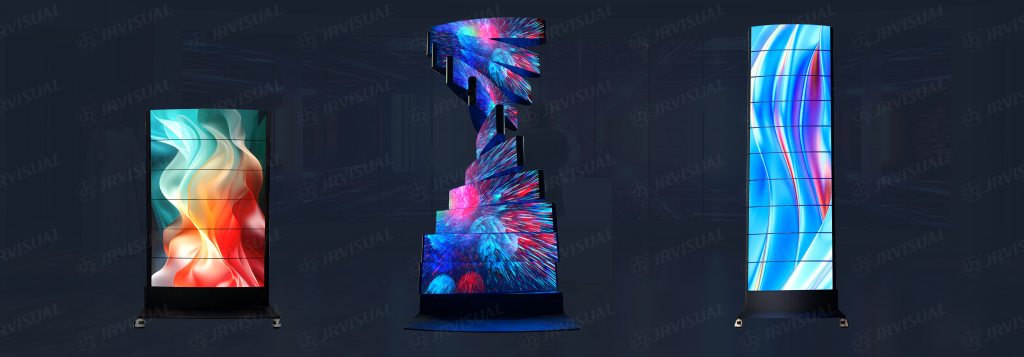Exhibition applications demand standout creativity, creating a truly unique experience. Nothing captures attention more than the combination of motion and image. As the ideal rotating LED screen for exhibitions in 2025, Jrvisual’s 3D DNA rotating LED screen delivers the pixel density, mechanical robustness, and content flexibility required for modern exhibitions. Specifically, JRVISUAL offers pixel pitches of 1.2mm, 1.5mm, 1.8mm, 1.9mm, and 2.0mm, supporting a variety of screen types (double-sided flat, double-sided curved, and triangular rotating LED screens). It can be infinitely rotated for continuous motion effects and is designed for 24/7 operation. It is customizable in size, supports centralized control, is easy to maintain, and offers high reliability. Why is this so important? Exhibitions demand the most creative visuals, minimal downtime, and easy installation. The 3D DNA rotating LED screen offers ultra-fine pixel pitch options for close viewing, while centralised content control enables curators to update the experience in real-time.
Best Visual Performance and Pixel Pitch for Rotating LED Screen for Exhibition Applications
Visual performance is the most important metric for exhibition LED displays. The JRVISUAL DNA rotating LED screen series offers a variety of pixel pitches, including 1.2mm, 1.5mm, 1.8mm, 1.9mm, and 2.0mm, allowing you to adjust image clarity based on average viewing distance and usage. For gallery installations and premium booths where viewers are within a few feet, a 1.2mm to 1.5mm pitch provides enhanced clarity and readability for fine text, realistic product renderings, and video content. For larger halls or displays viewed at close range, a 1.8mm to 2.0mm pitch offers the perfect balance between image fidelity and cost-effectiveness.
This rotating LED screen also supports high refresh rates, suitable for live camera feeds, and enables smooth motion without camera flicker. Industrial-grade calibration on the panel provides consistent white balance and color uniformity across the entire rotating surface. Furthermore, high contrast and deep blacks make motion and 3D illusions even more realistic, especially in dimly lit exhibition environments.

Superior Mechanical Design, Infinite Rotation, and Reliability in Rotating LED Screen
The appeal of rotating LED screens hinges on their mechanical reliability. For exhibition applications, stoppages or motor noise can disrupt the experience, while audiences expect continuous, smooth motion. The 3D DNA rotating LED screen addresses this issue with sophisticated engineering, utilizing a rugged, low-vibration drive system, industrial-grade bearings, and a compact gearbox module explicitly designed for infinite rotation to achieve a more precise mechanical structure.
The brushless motor, with its precise speed control and torque characteristics, is sized to match the screen quality and the required rotational power. Brushless motors offer quieter operation, longer life, and lower maintenance requirements. Furthermore, JRVISUAL designs its rotating LED screens to minimize radial/axial runout, ensuring a stable image at all speeds. For infinite rotation, Jrvisual uses a combination of highly flexible cables routed through sealed channels and, when necessary, employs specially designed rotary joints or slip ring alternatives to support high-frequency video signals and power without compromising performance.
Exhibition-Friendly Form Factor and Modular Construction
Rotating LED displays for exhibition applications require a design that prioritizes flexibility and adaptability. 3D rotating LED screens are available in various form factors, including double-sided flat screens, double-sided curved displays, and triangular rotating LED screens. This allows designers to balance aesthetics with space constraints.
Double-sided flat rotating LED screens are ideal for aisles, kiosks, or freestanding columns that require content on both sides. This classic screen form factor is ideal for dynamic signage, brand messaging, and looping videos that require 360-degree visibility. Double-sided curved rotating LED screens, on the other hand, are ideal for iconic installations that wrap around the viewer and create a fluid change of perspective as they move through the exhibit. Triangular rotating LED screens, on the other hand, offer three distinct display surfaces that can rotate to present different presentations, allowing each surface to display a different image, product demonstration, or language variation. Customization encompasses not only shape but also size, height, rotation speed, and finish. Jrvisual supports custom diameters and heights, allowing integration into atria or ceiling installations.

Content Management, Central Control, and 3D/Interactive Capabilities
A rotating LED screen serves as a display platform, and achieving a superior experience depends on both content strategy and control architecture. JRVISUAL provides a centralized control system for managing playback, motion synchronization, and multi-layer content composition. Central control simplifies scheduling, remote updates, and real-time response to audience interactions, making it ideal for multi-day exhibitions and traveling events.
JRVISUAL’s control ecosystem supports playlists, timed triggers, and remote content push. Curators can switch content across multiple rotating screens simultaneously, using preview and rollback features to prevent on-site errors. Motion and content synchronization creates 3D illusions by tightly linking rotation speed and camera angle to content playback. This feature enables advanced volumetric effects, including parallax and near-3D effects.
Simultaneously, it supports live feeds, pre-rendered 3D assets, interactive engines, and synchronized audio. This is crucial when rotating LED screens are part of a larger AV ecosystem within an exhibition or booth. This integrated control layer enables 3D rotating LED screens to become not only a visual centerpiece but also a content-driven core that adapts to audience behavior and brand objectives.
The Best Rotating Screen Solution for 2025
Choosing the right rotating LED screen for an exhibition application requires evaluating image quality, mechanical reliability, content control, and practicality of installation. JRVISUAL’s 3D DNA rotating LED screen addresses all these factors: it offers a fine selection of pixel pitches, multiple form factors, unlimited rotation, 24/7 operation, customization support, and centralized content control. For exhibition planners looking to create a compelling centerpiece exhibit in 2025, the 3D DNA rotating LED screen is the undisputed best choice.
Frequently Asked Questions (FAQs) about 3D DNA Rotating LED Screens
1. Q: What pixel pitch should be selected for rotating LED screens in museum exhibitions?
A: For museum exhibits where visitors observe details at close range, choose a pixel pitch between 1.2mm and 1.5mm. This density presents fine text and product details, supporting realistic 3D parallax.
2. Q: Can rotating LED screens operate continuously for multi-day exhibitions?
A: Yes. The 3D DNA rotating LED screen features an industrial-grade power supply, efficient heat dissipation, and easy-to-maintain modules for 24/7 operation.
3. Q: How does infinite rotation handle power and signal transmission?
A: JRVISUAL utilizes sealed cable channels, a highly flexible cable system, and, where necessary, a precision rotating transmission solution designed for high-frequency video and power. This design minimises wear and tear, maintaining signal integrity and enabling continuous rotation.
4. Q: Can it be customized to meet my brand’s size and content requirements?
A: Absolutely. JRVISUAL supports custom diameters, heights, surface geometries, and pixel pitches.

